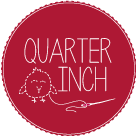Glue stick appliqué tute
'
This easy or some would say ‘cheats’ method of needleturn appliqué takes the scare factor out of needleturn. Most of the work is in the preparation leaving the actual stitching as the easy bit.
The method uses two products – Hugs ‘n Kisses Appliqué paper and a Glue pen – I use the Sewline brand.
Method:
Place a sheet of appliqué paper with the shiny (glue) side down on top of your template or design printed sheet. It is semitransparent so you can easily see the design through the paper. Trace each design or template shape onto the paper – I like to use a Sewline Ceramic pencil which glides on nicely. Note: if your appliqué design is directional you need to reverse it for this method. new note: if it is not reversed trace it onto the glue side of the paper – saves one step…
Cut out each shape carefully on the traced lines. This is the important part – be as careful as possible as this determines your final shape.
Fuse each shape to the wrong side of your chosen fabrics. You need to leave a large ¼” between shapes for seam allowances.
If you wish you can fussy cut your fabrics by positioning the shapes to suit.
Cut out each shape leaving an approximate 1/8” seam allowance.
Using the glue pen run a line of glue along the edge of the paper template – it only needs to be light and right on the edge.
Using your thumb and forefinger gently press over the seam allowance onto the glue. You want to fold the fabric on the edge of the paper – but you don’t want to fold the paper as well, it doesn’t take too long to get the feel of the edge of the paper and where to fold to.
If the end of your appliqué piece is going to be under another piece in the final design you do not need to glue and fold these edges over.
You do not need to clip into outer curves. Our seam allowance is small and often on the bias so clipping is not necessary. Just gently fold/pleat around curves a small step at a time so you do not get points. If you are having trouble eliminating points try trimming back the seam allowance a little further.
If you have tails like on this leaf, just leave those they will be dealt with later.
Your prepared shape!
You will need to clip on inner curves – but not as much as you may be used to. Just clip where you absolutely need to to enable the seam allowances to fold in nicely. Inner points need to be clipped to the edge of the paper.
Continue glueing until all shapes are prepared.
Position your background fabric over the design sheet. Use a lightbox if you cannot easily see through the fabric.
Position and layer all appliqué pieces following the design you can see underneath. Use the glue pen or for larger projects Roxanne’s Glue baste it to secure all pieces at once. Just layer them up until the complete block is ready for stitching.
Now you can stitch all pieces down as you would for your normal appliqué method. I use a Hugs ‘n Kisses appliqué needle and Superior Bottomline threads but you can use your thread of choice. When stitching down those tails that are showing, stitch to the point and do a double stitch to hold, tuck under the tail with the tip of your needle and continue in the new direction.
No need to remove the papers – when it is washed they will just dissolve and soften into safe fibres in your quilt project.
Happy appliquéing
Hugs
Helen
Note: all of our Hugs ‘n Kisses appliqué patterns include the full design sheet along with reversed where necessary templates and appliqué shapes for tracing. We are considering including preprinted Appliqué paper in our patterns in the future – so you can just cut out, glue and stitch! Watch this space!
'
